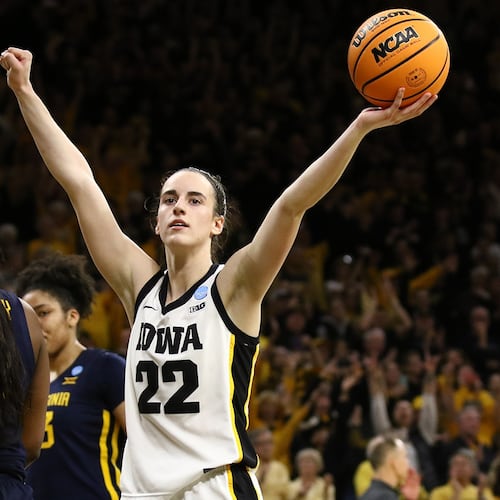Ronald Acuna arrived in the majors in late April as baseball’s No. 1 prospect. Despite missing a month with a sprained knee, he was voted the National League’s rookie of the year, taking 27 of 30 first-place votes, and he finished 12th in MVP balloting. He posted a 4.1 WAR, as calculated by Baseball-Reference. He lived up to the hype. Obvious question: What, besides world domination, is next?
Among rookie position players, the great cautionary tale is Joe Charboneau, who was the 1980 ROY for Cleveland and who, in part because of a back injury, played his 201st and final big-league game in 1982. More recently and more locally, Jason Heyward posted a 6.4 WAR as a Braves rookie in 2010. To say he has since been a bust would be incorrect, but it’s true that, in eight seasons of trying, he has bettered his freshman WAR only once.
Like Acuna, Heyward was considered the No. 1 prospect. Like the 20-year-old Acuna, the 20-year-old Heyward made an immediate splash. (Three-run homer on opening day.) Like Acuna, Heyward appeared a generational talent. But the holes in his swing have taken such a toll that, since signing with the Cubs in 2015 for $184 million over eight seasons, he has posted an OPS of .688, which isn’t what anybody had in mind. His rookie OPS was .849; it remains his big-league peak.
More on Braves
» Michael Cunningham: Youthful Braves offer potential
» When will SunTrust Park change its name?
» Freddie Freeman is more to Braves than just numbers
We cannot know what the future holds for anyone, Ronald Acuna included. We can, however, look back on the early careers of the greatest outfielders who arrived in the majors after World War II as to how Acuna’s career might track.
Mickey Mantle: Made debut at 19 in 1951; 1.5 WAR as rookie; 6.4 WAR his second season, which saw him generate a league-best OPS of .924 and finish third in MVP voting; won the first of three MVPs in 1956, his Triple Crown season.
Willie Mays: Made debut at 20 in 1951, five weeks after Mantle; was voted rookie of the year after posting a 4.0 WAR; missed most of the 1952 season and all of 1953 because of military service; 8.6 WAR in 1954, in which he led league in batting average, slugging and OPS and won first of two MVPs.
Hank Aaron: Made debut at 20 in 1954; 1.3 WAR as rookie; had WAR of at least 6.3 from 1955 through 1969 and finished in the top 10 of MVP voting 12 times, winning in 1957.
Roberto Clemente: Made debut at 20 in 1955; minus-0.3 WAR as rookie; career didn't begin to take off until 1958, when he began the first of 15 consecutive seasons with 2.8 WAR or better; won batting title four times, MVP in 1966; died in plane crash Dec. 31, 1972.
Frank Robinson: Made debut at 20 in 1956; 6.6 WAR as rookie, leading the league in runs and winning ROY; 6.9 WAR the next season; MVP for Cincinnati in 1961 and Baltimore in 1966, his Triple Crown season.
Carl Yastrzemski: Made debut at 21 in 1961; minus-0.3 WAR as rookie; 4.2 WAR his second season, 6.6 his third; led league in batting three times in six years and won Triple Crown and MVP in 1967.
Reggie Jackson: Made debut at 21 in 1967; minus-0.7 WAR in limited duty as rookie; 5.2 WAR in 1968, 9.2 in 1969; led league in homers four times and slugging three times; MVP in 1974.
Rickey Henderson: Made debut at 20 in 1979; minus-0.9 WAR as rookie; 8.8 WAR the next season, beginning a run of 14 years with a WAR of 3.9 or better; led league in runs five times, in stolen bases 12 times and OPS in 1990, when he was voted MVP.
Ken Griffey Jr.: Made debut at 19 in 1989; 3.3 WAR as rookie; 5.2 WAR the next year, 7.1 the next; didn't have a WAR under 3.3 until his 13th season; led league in homers four times; MVP in 1997.
Mike Trout: Made debut at 19 in July 2011; 10.5 WAR in 2012, his full rookie season, after which he was voted ROY and finished second in MVP balloting; has led league in OPS three times and runs four times; MVP in 2014 and 2016.
Bryce Harper: Made debut at 19 in 2012; 5.2 WAR as rookie, was voted ROY; has bettered that WAR only with a 10.0 in 2015, his MVP year.
From that list of 11, we note: All were 21 or under at time of their call-ups; only Clemente was anything approaching a slow grower; all grew into MVP-caliber players, and all but Trout and Harper, who are still going, are enshrined in Cooperstown. Then again, we could have used the first nine as touchstones for Heyward in the spring of 2011, and today we’d feel a bit silly having done so.
That said, position players – meaning hitters – tend to be easier to project than pitchers, who live in constant fear of an elbow twinge. (Heyward’s issue was that he stopped hitting.) If the above histories teach us anything, it’s that great young players tend to get greater very fast. Ronald Acuna is a great young player.
About the Author
The Latest
Featured


